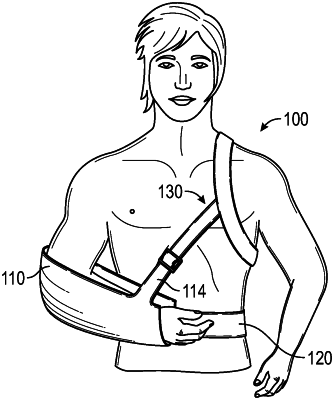| CPC A61F 5/3738 (2013.01) [A61F 5/373 (2013.01); A61F 5/3753 (2013.01)] | 15 Claims |

|
1. A shoulder-immobilizing apparatus, the apparatus comprising:
a forearm sling configured to receive an elbow, a forearm and a wrist of a first arm of a user, the forearm sling further comprising:
a first fastener configured for fastening a posterior strap to a proximal portion of the forearm sling adjacent to the elbow of the user,
a second fastener configured for fastening an anterior strap to a distal portion of the forearm sling adjacent to the wrist of the user;
a contralateral strap holder comprising:
a circumferential shoulder strap configured to wrap around a shoulder of a second arm of the user to form an ellipsoid opening that seats against a pectoral region, a scapular region and a lateral outer portion of the second arm,
the posterior strap having a first swivel fastener configured to rotatably couple to one or more positions on a posterior portion of the circumferential shoulder strap, and
the anterior strap having a second swivel fastener configured to rotatably couple to one or more positions on an anterior portion of the circumferential shoulder strap,
wherein the contralateral strap holder does not exert a force against a neck of the user; and
an abduction cushion configured to be disposed between the forearm sling and a torso of the user, thereby abducting the first arm of the user by a desired abduction angle, the abduction cushion comprising:
a first padded cushion;
a second padded cushion; and
a vacuum bladder disposed between the first and second padded cushions, the vacuum bladder formed of a material configured to exert an intrinsic expanding force such that:
applying a vacuum pressure sufficiently below ambient atmospheric pressure to the vacuum bladder overcomes the intrinsic expanding force of the material of the vacuum bladder, thereby contracting the vacuum bladder and bringing the first and second padded cushions closer together, and
the vacuum bladder is held in an at least partially expanded state by the expanded intrinsic expanding force of the material of the vacuum bladder when a pressure greater than the vacuum pressure is applied to the vacuum bladder.
|